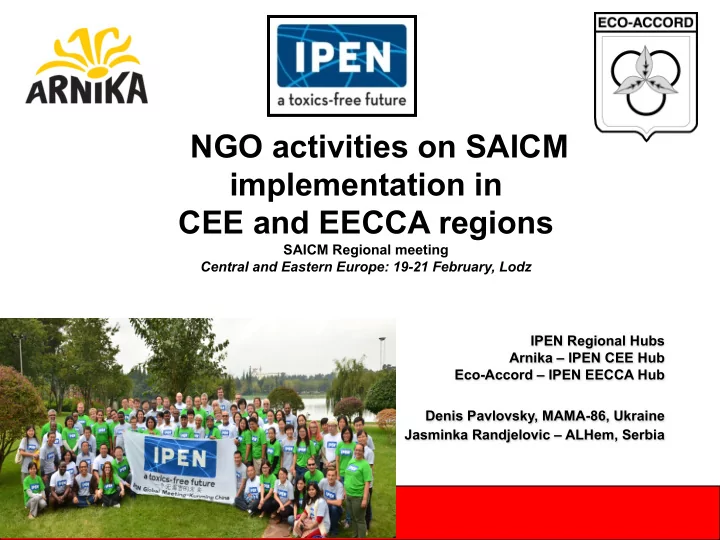

NGO activities on SAICM implementation in CEE and EECCA regions SAICM Regional meeting Central and Eastern Europe: 19-21 February, Lodz IPEN Regional Hubs Arnika – IPEN CEE Hub Eco-Accord – IPEN EECCA Hub Denis Pavlovsky, MAMA-86, Ukraine Jasminka Randjelovic – ALHem, Serbia
IPEN - A Global NGO Network Thematic areas: Chemical conventions ü Safe Chemicals Management (SAICM) ü NGOs, governments, private sector ü Global, regional, national, community levels ü 2
NGO Engagement in the SAICM Process IPEN and IPEN regional Hubs organize NGO engagement in the SAICM process including the meetings of the International Conference on Chemicals Management (ICCM), SAICM regional meetings, SAICM working groups, and the SAICM Bureau. IPEN and IPEN Hubs also organize and promote local, national, regional and international NGO interventions aimed at advancing SAICM’s Overarching Policy Strategy and the SAICM Global Plan of Action. IPEN three major areas of work: • Strengthening International Chemical Policies & Strategies • Halting the Spread of Toxic Metals • Reducing and Eliminating the World’s Most Hazardous Chemicals
IPEN contribution to SAICM EPI v Raised awareness v Made recommendations v Engaged civil society v Built capacity and developed educational tools and activities v Worked at the international and national policy level
IPEN Lead Free Paint Campaign Strategies Camapaign • 88 IPEN PO studies done/ongoing in 55 countries (almost 30% of all countries) • National regulations in 5 countries, Draft regulations in 4 countries, Regional standard(s) in East Africa • National and/or regional campaign ongoing in all IPEN regions • International collaborations useful for IPEN in general (US EPA, UN Environment, etc.) www.ipen.org
Examples of lead in paint in EECCA Armenia 2016 49 samples manufactured in different countries 9 samples – above 10,000ppm 180,000 ppm (yellow, manufactured in Armenia, brand headquarters – Iran) 29 Paints containing lead above 90 ppm were manufactured in Iran, Russia, Turkey, Ukraine, and United Arab Emirates.
IPEN suggestions for risk reduction activities Lead in paint : • •By 2020, analytical data on lead in paint from 80 developing and transition countries is publicly available as a contribution to enable all countries to: 1) Establish effective legally-binding regulatory controls by 2022 on lead decorative paints and lead paints for other applications most likely to contribute to children’s lead exposure; and 2) Establish effective legally-binding regulatory controls by 2027 prohibiting the use of lead in paint, varnishes, stains, enamels, glazes, primers or other coatings. •By 2030 publicly available monitoring shows that no varnishes, lacquers, stains, enamels, glazes, primers or coatings produced, sold, exported, imported or used for any purpose contain lead.
Focus on risk reduction activities where substantial achievements can be made between now and 2020 with concerted effort: more vigorous implementation of SAICM EPIs, selected elements of the GPA and other issues of concern Chemicals in products: IPEN generated new data on toxic chemicals in toys in EU, CEE and EECCA countries http://www.ipen.org/news/press-release-arnika-toxic-toy-toxic-waste http://www.ipen.org/site/eastern-europe-caucuses-central-asia-results Lead = 2170 mg/kg Arsenic = 98 mg/kg Antimony = 339 mg/kg IPEN calls for risk reduction activities on chemicals in products: • By 2020 the implementation process of the SAICM Chemicals in Products Programme starts in at least two sectors in two SAICM regions with at least 20 countries involved. • By 2020 at least 50 companies from at least two product sectors join the CiP Programme. • By 2020 awareness raised about the benefits of disclosure information on chemicals in products and the role of consumers • By 2020 at least 5 governments started using economic instruments to motivate information disclosure.
IPEN welcomed ICCM4 major outcomes: A focus on concrete risk reduction activities was made that minimize real risks associated with chemical exposure between now and 2020. Chemicals in products Project (CiP) - CiP Programme and Guidance adopted: companies will identify and disclose harmful chemicals in their products and supply chains; - Activities on awareness raising and pilot projects are part of the resolution - Synergy with other EPIs highlighted IPEN continues working with stakeholders to ensure: - Information on chemicals relating to the health and safety of humans and the environment should not be regarded as confidential. - Need for awareness raising on products’ lifecycle; - Need for harmonized labels; - Disclose inf. on regulated and non-regulated chemicals; - Use SAICM criteria to identify chemicals for disclosure; - Role of NGOs in CiP implementation
THE PRESENCE OF BISPHENOL A (BPA) IN THERMAL PAPER www.alhem.rs www.facebook.com/ Monitoring of use and presence of dangerous chemicals ALHem in products placed on the Serbian market office@alhem.rs The results from 33 samples have demonstratedted that: The papers for cash receipts imported to Serbia contain BPA Carbord packing made of recycled paper is contaminated by BPA Out of 5 requests for information on SVHC presence in product, 4 answers were received, out of which only one was in compliance with regulations in place. ALHem calls upon institutions from state and public sectors, companies from private sector, especially upon trade chains, to replace thermal paper with alternative free of bisphenols
Thank you!
Recommend
More recommend